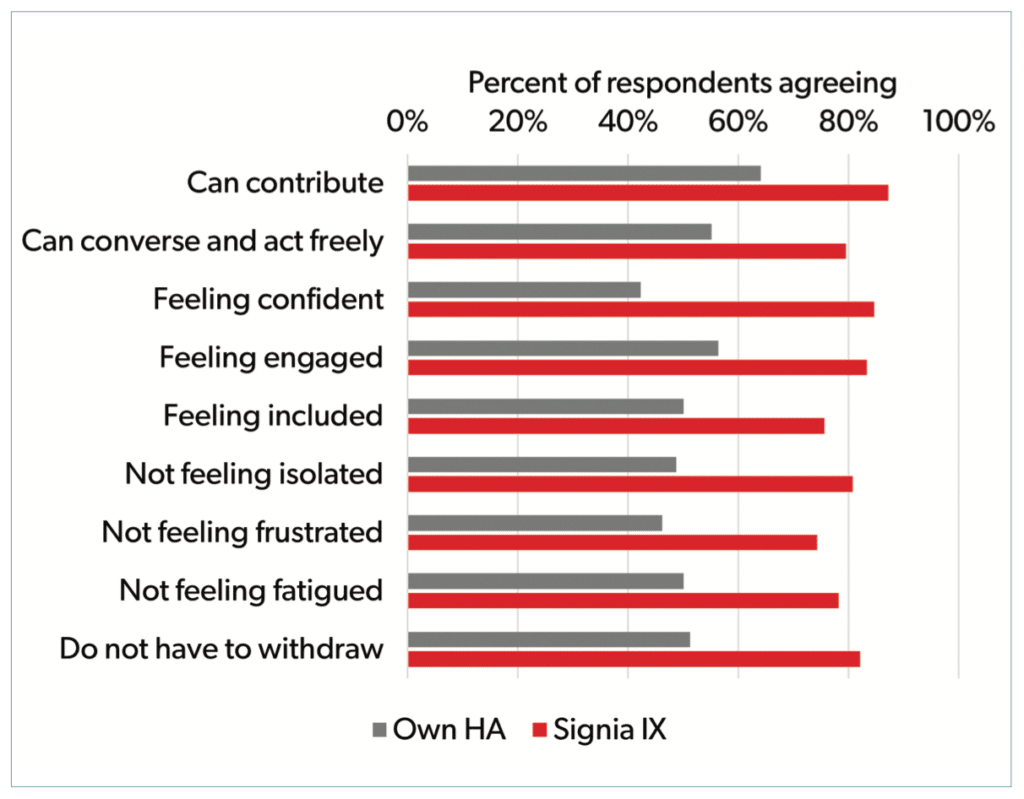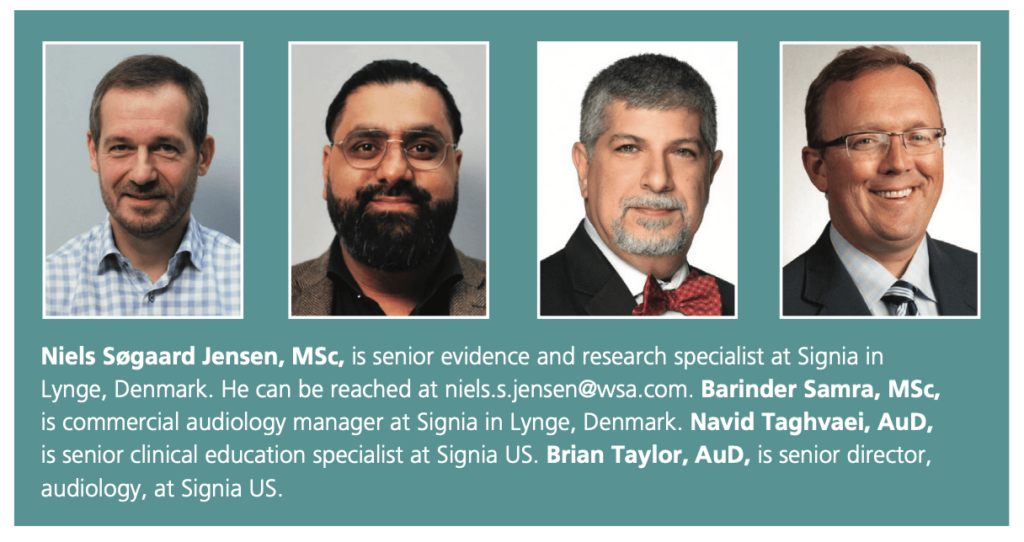Figure 1. Simplified diagram showing the functionality of the RealTime Conversation Enhancement technology implemented in the Signia Integrated Xperience hearing aids. Bold lines indicate the flow of the sound streams, while thin dotted lines indicate control paths.
This article discusses how the conversation experience can be affected by hearing loss, and what hearing care professionals can do to improve it. The article presents results from an international survey assessing a new type of hearing aid technology from Signia that has been designed to support the wearer in challenging group conversations. The results provide valuable insights into how enhancing conversation performance yields perceptual, emotional, and behavioral benefits for the wearer.
By Niels Søgaard Jensen, MSc; Barinder Samra, MSc; Navid Taghvaei, AuD; and Brian Taylor, AuD
Face-to-face conversations are the foundation of human interaction. The ability to communicate, to exchange information, to inspire, and to be inspired by listening and talking to other people during a conversation is an essential part of the human experience. The ability to hear and understand communication partners is an indispensable prerequisite of any conversational experience. As is well known, a hearing loss will have a deteriorating effect on this ability, especially when the conversation takes place in a noisy environment. While hearing aid technology has improved over the past years, conversations in the presence of background noise and conversations in large groups are still among the listening situations where hearing aid wearers report the lowest satisfaction with their hearing abilities.1
Nicoras and colleagues2 have investigated which factors are required to make conversations successful, both for people with normal hearing (NH) and people with hearing loss (HL). Not surprisingly, both groups identified “being able to listen easily” as the most important factor, with the HL group rating the importance higher than the NH group. Interestingly, both groups found this factor to be more vital in group conversations than in one-on-one conversations. Another key factor in making conversations successful was “sharing information as desired,” reflecting that conversations are often task-oriented with information exchange as the primary goal. Thus, conversations are not solely about listening; they also involve each communication partner actively contributing to the conversation to achieve a desired outcome.
Hearing care professionals (HCPs) fully recognize the importance of conversations, as difficulties in these situations are often the primary motivator for people with hearing loss to seek help. To offer effective assistance, HCPs must comprehend the underlying conversational needs of individuals with hearing loss and address these needs through counseling and technology, typically in the form of hearing aids.
People with hearing loss can apply a number of practical behavioral strategies to improve their own conversational experience, e.g. when dining out in a restaurant.3 The HCP can counsel on using these strategies, which can be beneficial both with and without hearing aids. Under the right circumstances, these strategies can have a significant positive impact. However, for many individuals with hearing loss, their conversational experience, especially in noisy environments and group settings, heavily relies on their hearing aids. Therefore, the HCP should be aware that some hearing aid technologies are specifically designed to improve the conversational experience.
In this article we present results from an international survey, investigating how wearers experience conversations when wearing Signia Integrated Xperience (IX) hearing aids with the RealTime Conversation Enhancement (RTCE) technology, which was developed specifically to address challenging group conversations in noise. Before showing and discussing the results, we will briefly introduce the technology.
RealTime Conversation Enhancement
In short, RTCE is based on an advanced analysis of the conversational environment, which allows detection of relevant nearby talkers in a conversation. The analysis steers the multi-stream sound processing where different speakers in the front hemisphere are processed in different streams, allowing the relevant conversation partners to be highlighted and disturbing noise to be suppressed. This increases the contrast between speakers and background noise and thereby the ability to follow the conversation, while the wearer still feels immersed in the surroundings. The processing happens in real time and allows constant tracking of the conversation partners, even when they move or when the wearer turns their head. The hearing aids continuously analyze and augment the sound environment, enhancing speech and adapting to the conversational scene, as shown in Figure 1. More details about the technology and the technical and perceptual benefits it provides in a group conversation scenario can be found in separate articles and white papers.4-6

Figure 2. Percentage of respondents agreeing with each of nine different statements related to the experience of being in a conversation, when wearing their own hearing aids and Signia IX.
Survey
To investigate the real-world listening experience provided by Signia IX and RTCE, we conducted an international survey in the US, the UK, Germany, Italy, Taiwan, and Australia. A total of 78 respondents, all experienced hearing aid wearers, completed the survey. They were all fitted with Signia Pure C&G IX hearing aids and wore them in their own everyday lives before assessing them by answering a series of questions in an online questionnaire. Furthermore, the respondents answered the same questions for their own hearing aids, and additionally, they provided some feedback on their preference between Signia IX and their own hearing aids. More details about the survey protocol are available in a white paper.7
Further reading: Multi-Stream Architecture for Improved Conversation Performance
Real-World Conversation Experience
In the presentation of the results, we will focus on the part of the survey that related directly to the respondents’ experiences of being in conversations. We assessed this by asking the respondents how much they agreed with nine different statements related to being in conversations, e.g., “wearing the hearing aids, I can contribute to conversations.” The statements had a special focus on the emotional and behavioral aspects of being in a conversation, with items addressing the ability to converse and act freely; the feeling of confidence, engagement, and inclusion; the feeling of not being isolated, frustrated, and fatigued; and the sense of not having to withdraw. The respondents rated their agreement with each statement on a 7-point Likert scale going from “strongly disagree” to “strongly agree.”
In Figure 2, the bar graph shows, for each of the nine statements for both Signia IX and the respondents’ own hearing aids, the percentage of respondents who provided a rating in the upper (agreement) end of the 7-point rating scale (Top 3 box scores), indicating some level of agreement with the given statement when wearing the given hearing aids.
Some general observations can be made in Figure 2. Overall, we see a clear positive effect for Signia IX. When wearing Signia IX, the proportions of respondents agreeing with the various statements ranged between 74% and 87%. With their own hearing aids, the proportions ranged between 43% and 64%. Thus, for all nine items in Figure 2, the proportion of wearers with a positive conversation experience was substantially increased by Signia IX, which suggests RTCE can improve the conversation experience for a large group of wearers.
Going a bit deeper into the individual survey items, it is interesting to observe the many facets of a conversation where the right hearing aids can make a difference. With Signia IX, 87% of respondents felt they could contribute to a conversation (compared to 64% with their own hearing aids), and 79% felt they could converse and act freely (compared to 55% with their own hearing aids). These feelings were often accompanied by feelings of confidence (85%), engagement (83%), and inclusion (76%), and by the absence of negative feelings like isolation (81%), frustration (74%), and fatigue (78%), in all cases with more than a 20-percentage point difference to the similar proportions observed for their own hearing aids. As a likely consequence of their improved conversation experience, 82% of the respondents reported that they did not have to withdraw from group conversations when wearing Signia IX, as compared to only 51% with their own hearing aids.
All nine improvements in agreement rates offered by Signia IX in comparison to respondents’ own hearing aids were statistically significant according to a two-proportion z-test with a Benjamini-Hochberg correction for multiple comparisons (all p < .05). That is, a significantly higher proportion of respondents had positive experiences when wearing Signia IX during conversations as compared to when they were wearing their own hearing aids.
In agreement with the conversation experience ratings, 82% of the respondents picked Signia IX when asked directly which hearing aids provided the best conversation experience. A preference for Signia IX was also observed in the other outcome domains included in the survey.7
Discussion
The respondents’ ratings in the survey illustrate how the experience of having a hearing loss, wearing hearing aids, and being in a conversational situation is complex and multifaceted. The results show how hearing aids that offer a dedicated signal processing scheme can make a substantial difference, not only on the wearer’s ability to understand what their communication partners say, but on the entire emotional experience of being part of and contributing actively to the conversation. The data suggest that hearing aids designed to address the conversational situation, like the Signia IX hearing aids investigated in the survey, will allow the wearer to be more confident and engaged, and the hearing aids will help prevent feelings of frustration and social isolation, which are among the most detrimental consequences of an untreated hearing loss.8
To provide the best possible hearing aid solution to a person with hearing loss who struggles in challenging conversational situations, it is of course important for the HCP to be aware of how hearing aid technology addresses the acoustic challenges associated with conversational situations, and in turn, can explain to the wearer how the hearing aid performance will be optimized in these situations. However, it is just as important that the HCP be aware of—and can talk to the wearer about—the perceptual, emotional, and behavioral consequences of hearing loss on conversations. Further, it is imperative for HCPs to address how these consequences can be reduced by hearing aids which can markedly improve the entire conversational experience, and ultimately the wearer’s quality of life.
In this article, we have discussed the conversational situation, the challenges it provides to persons with hearing loss, and the roles of the hearing care professional and the hearing aid technology when these challenges are addressed with hearing aids. We have presented the RealTime Conversation Enhancement multi-stream processing approach implemented in Signia Integrated Xperience, which was specifically designed to address the challenges of group conversations in noise. Data from an international survey were presented to demonstrate the substantial perceptual, emotional, and behavioral benefits provided by Signia IX in real-world conversations. The data show how Signia IX significantly can improve the wearers’ ability to confidently participate in and contribute to the conversations they engage in during their normal everyday life.

Original citation for this article: Jensen N, Samra B, Taghvaei N, Taylor B, Improving the Real-World Conversation Experience With a Multi-Stream Architecture? Hearing Review. 2024;31(9):16-21.
References:
- Picou EM. Hearing aid benefit and satisfaction results from the MarkeTrak 2022 survey: Importance of features and hearing care professionals. Seminars in Hearing. 2022;43(4):301-316.
- Nicoras R, Gotowiec S, Hadley LV, Smeds K, Naylor G. Conversation success in one-to-one and group conversation: a group concept mapping study of adults with normal and impaired hearing. Int J Audiol. 2023;62(9):868-876.
- Eberts S. Dining Out for People with Hearing Loss. The Hearing Journal. 2020;73(1):16.
- Jensen NS, Samra B, Kamkar Parsi H, Bilert S, Taylor B. Power the conversation with Signia Integrated Xperience and RealTime Conversation Enhancement. Signia White Paper. 2023. Retrieved from www.signia-library.com.
- Jensen NS, Wilson C, Kamkar Parsi H, Taylor B. Improving the signal-to-noise ratio in group conversations with Signia Integrated Xperience and RealTime Conversation Enhancement. Signia White Paper. 2023. Retrieved from www.signia-library.com.
- Jensen NS, Samra B, Kamkar Parsi H, Bilert S, Taylor B. Multi-Stream Architecture for Improved Conversation Performance. Hearing Review. 2023;30(10):20-23.
- Jensen NS, Taghvaei N, Taylor B, Samra B. Real-world assessment of Signia Integrated Xperience with RealTime Conversation Enhancement. Signia White Paper. 2024. Retrieved from www.signia-library.com.
- Shukla A, Harper M, Pedersen E, et al. Hearing Loss, Loneliness, and Social Isolation: A Systematic Review. Otolaryngol Head Neck Surg. 2020;162(5):622-633.





